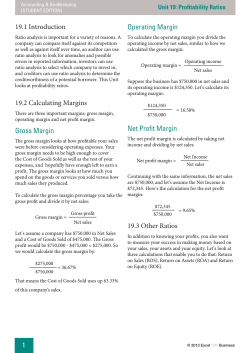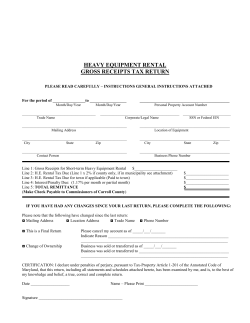
Calculating Retail Gross Margin
Calculating Retail Gross Margin Understanding Gross Margin, $ Margin, Gross Profit and Mark Up Gross Margin - it is a confusing phrase and as a retailer, it is something you should be very conversant with. Let’s start at the start – what is Gross Margin? Gross Margin can be defined as the difference between the cost price and the sell price. An easier explanation might be that Gross Margin is the amount of money left over after you have paid the Supplier (Vendor, Wholesaler or Manufacturer), for the product. There are effectively three different ways Gross Margin can be described: Gross Margin Mark Up $ GP% To try to understand that more fully, take a look at the box below. In both examples the cost price is $1.00 and the sell price is $2.00. The dollar element is easy to determine because it is identical in both instances - that is a $1.00 margin. Harder to determine is the Mark Up% and the GP%. Mark Up% is determined by getting the profit (we know that is $1.00 already) and dividing that by the cost price, in this case also $1.00. So $1.00/$1.00 is not surprisingly, 100%. GP% is determined by getting the profit in dollar terms (again, obviously $1.00) and then dividing it into the selling price. In this case that is $1.00/$2.00 which equals 50%. There are three different answers to “what is the Gross Margin”? Mark Up% Sell: $2.00 Cost: $1.00 Mark Up% Dollar $ GP% 100% $1.00 50% GP% Sell: $2.00 Cost: $1.00 Margin is $1.00 and 100%, because: Margin is $1.00 and 50%, because: Equation is: Profit/Cost = $1.00/$1.00 = 100% Equations is: Profit/Sell = $1.00/$2.00 = 50% An easy way to distinguish between the two is to use these very basic and arguably crude definitions: Mark Up: Is how much money you add on to the purchase price of a product. GP: Is how much money you have left after you have paid the supplier for the product. Should you use GP or Mark Up? The strong, clear and unambiguous advice is to use GP when measuring a business’ profit. It is the benchmark metric. It is the number used by Accountants, Banks, Insurance companies etc. Mark Up is a metric used primarily to help retailers determine how much money to add on to the purchase price. Mark Up is still used by the Supplier/Vendor community. It should also be noted that Mark Up is still required in some retail calculations so it retains a useful function. Note: GST/VAT, state and federal taxes are excluded from all elements of any margin calculation. www.zumocalculators.com The difference between Gross Margin and Net Profit Gross Margin is reasonably simple once you know whether you are talking about $ Margin, Mark Up or Gross Profit. To add further confusion into the mix is the question of Net Profit. What is the difference between Gross Margin and Net Profit? With Gross Margin, the only cost you deduct from the value of sales (Net Sales). To understand Net Profit, you need to remove the other costs incurred in running the business. As a retailer you might be making a superb Gross Margin (GP), but the other costs of running the business could be so high you still don’t make enough to survive. It’s obviously important to know both. Consider the following simplified Profit and Loss Statement for a retailer. Profit and Loss Statement (Simplified) Sales Less Cost of Goods Gross Margin (Gross Profit) $2,500,000 $1,675,000 $ 825,000 Less Operating Expenses Wages Power Rent Insurance Total Operating Expenses $ 300,000 $ 30,000 $ 100,000 $ 70,000 $ 500,000 Earnings before interest and tax $ 325,000 100% 67% 33% 12.0% 1.2% 4.0% 2.8% 20.0% 13.0% Interest $ 50,000 2.0% Net Profit (Before Tax) $ 275,000 11.0% Confusingly, different organisations and institutions have different ways of presenting this information. For those familiar with these types of documents, you might be seeking an Earnings Before Interest and Tax (EBIT) number. Of course, there is an EBIT here - it is just not as obvious as perhaps it could be. Many organisations measure EBIT, to calculate this number, means taking our Net Profit number (Before Tax) of $275,000 in the example on this page and adding Interest back into it, from the line above. In our example this makes the EBIT $325,000. Why bother doing that? Different organisations and different situations can have a variety of situations – for example one organisation might have enormous borrowings and huge interest costs, while another might not. An EBIT lets an investor, owner, bank or accountant quickly assess whether this is the case or not and how healthy a business is. Net Profit: This tells you the profit after paying all the costs a business incurs, other than tax. Why not include Tax - simply because Tax is treated in different ways depending on the situation – for example depreciation on equipment etc. can profoundly impact an organisations profit result. To ensure a level playing field and so that all businesses are able to be assessed on a comparative basis, both EBIT and Net Profit are very common measures, with Net Profit being the most instructive. www.zumocalculators.com It is worth making note of two other margins that are used for what will become obvious reasons: Initial Margin Initial Margin is also known as Initial Mark Up. This calculation explains why Mark Up can be useful! This margin is used by retailers that have a propensity to mark down prices to exit stock. The most obvious example of this is apparel retailers. There are some sizes or colours that consumers just don’t seem to want, well, until they are heavily marked down anyway. On this basis, it is important to calculate your margins being aware that as the “season” or time progresses, you will have to sell the product at a discounted price to exit it. Not all retailers use this process as retailers of non-fashion items (food, pharmaceuticals, fuel, liquor etc.) won’t typically use this margin at all. Retailers using this margin will need to know what their likely price reductions are going to be. Past history is often a good indicator. Using this margin helps you establish an initial margin before you start to reduce the price at the end. Weighted Gross Margin A commonly used margin measure is Weighted Gross Margin, also known as Weighted Gross Profit. This calculation is used to determine the actual GP% you achieve including the impact of promotions. It is calculated by considering how many units you have sold at the different GP%'s then the average margin for a product, category or business is deduced. In fact there are often three GP%'s inside a category. The first is the "shelf GP%", the second is the "Promotional GP%" and finally there is the "Weighted Average" of the first two elements combined. The category GP% average can be pulled down through overzealous use of promotions or by competitive pressures. Improving margins? It is all very well to understand what margin means, but a more challenging question to answer is how do can margins be improved? Let’s consider the marketing “P’s” to give us some guidance. The 7 “P’s” of marketing are: Product, Place, People, Price, Promotion, Presentation and Positioning. Using all 7 of the marketing P’s as headings, here are some things you might consider doing to improve margin: Product - review your buying arrangements - get your product range right by using high quality plan-o-grams - make sure shelves look well stocked - minimise shrink by having good inwards goods receiving and a tidy, organised storeroom - use the new product selector calculator on this web site to determine new products - use the GMROII deal estimator on this website to determine whether a deal is profitable Place - have an excellent store layout - do not clutter walk ways, ensure bins and floor stands don’t crowd walkways - provide excitement in-store by using promotional ends and bins in high traffic areas - measure space performance using GP$/m2 on this web site www.zumocalculators.com People - train staff in product knowledge to enable them to offer consistently good service - have enough staff at the right times, manage the peaks - have clear role responsibility - consistent uniform and name badge for all staff - have documented and measured service standards (greeting, farewell, cash handling etc.) - monitor performance levels of staff using the average sale calculator on this site Price - determine your pricing strategy by category – competitive, cost plus, EDLP - be price aware of competitors (this doesn’t mean price match) - get the basics right – make sure all products are clearly tickets, with tickets on the left - use the Terms – Supplier calculator on this website to assess vendor support - use the Open To Buy (OTB) tools on this website to make sure you don’t over stock the store Promotion - utilise a good promotional program - consider running your own Local Area Marketing (LAM) promotions - use the promotional forecaster and promotional analysis tools on this web site Presentation - order intelligently to avoid out of stocks - where out of stocks occur use “Out of Stock” cards have a process to evaluate your store standards each shift, every day and every week Positioning - how is your business positioned: o community o discount o convenience o category killer - check that your store colours modern, attractive and in line with your store position - check that your store is well presented, clean and appealing inside and out Summary The benchmark margins are Gross Profit % and Gross Profit$. GP% tells you, in percentage terms, how many much money you have left after you have paid the supplier (vendor, wholesaler, manufacturer or distributor) for the product. There is an old saying, you don’t bank percentages which is a reason given for measuring GP$. The reality is, both should be measured to ensure robust financial health. Mark Up has limited use, but is required when calculating Initial Margin. There are numerous methods for improving margin which have been suggested above. There are many more which should be investigated in each unique retail situation. For more information on margins and calculators which explain each margin fully visit: www.zumocalculators.com www.zumocalculators.com
© Copyright 2025





















